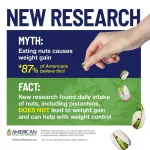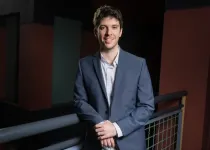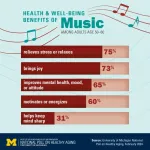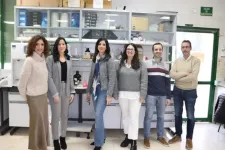(Press-News.org) Highlights:
Wastewater, even when treated, can deliver antimicrobial resistance genes to rivers.
Further research is needed on if rivers function as a protective barrier.
Researchers subjected biofilms from pristine rivers to wastewater.
Antibiotic resistant bacteria from wastewater successfully integrated at first, but in the warmest water were edged out by naturally occurring microbes.
The study suggests that temperature can influence the microbial competition in rivers.
Washington, D.C.—Antimicrobial resistant genes (ARGs) from wastewater can end up in natural biofilms in rivers, but they may not stick around very long. This week in mSphere, researchers report that after ARGs are introduced to a river they invade and initially join natural biofilms.
But as the temperature of the river increases, the abundance of those invasive ARGs drops off significantly, suggesting that the already-present community of microbes edge out the resistant newcomers. For river water at 30 degrees Celsius (86 degrees Fahrenheit), the level of ARGs returned to its initial state after only 2 weeks.
The finding suggests that rivers may offer a kind of defense against the spread of ARGs in wastewater. It was also contrary to what the researchers expected. Most ARGs in wastewater originate in human feces and thrive at the temperature of the human body, which is higher than most waterways. The microbiologists anticipated that warm rivers would be a welcome environment.
“We thought they should be rather well-adapted to higher temperatures,” said microbiologist Uli Klümper, Ph.D., at Technische Universität Dresden’s Institute of Hydrobiology. “So if river temperatures are rising with climate change, we wanted to know if these bacteria from wastewater would have an easier time integrating with the natural biofilms.” Klümper co-led the study with his Ph.D. student Kenyum Bagra, who joined TU Dresden on a DAAD exchange fellowship from the Indian Institute of Technology Roorkee, led the study. The work was funded through the ANTIVERSA project by BiodivERsA, a European biodiversity organization.
Klümper, Bagra and their colleagues first immersed 27 glass slides in the Lockwitzbach River, in eastern Germany, for a month. “It’s relatively pristine,” Klümper said. They collected the slides, which had amassed a natural biofilm from the river, and immersed them in artificial river systems at 1 of 3 temperatures. After a week, they observed that the abundance of naturally occurring ARGs increased in the warmest water, at 30 degrees Celsius.
Then, they exposed all the test slides to wastewater for 1 day and monitored the abundance of ARGs, both those that occurred naturally and those from wastewater, over the next 2 weeks. The ARGs from the wastewater readily invaded the biofilm in all 3 cases, with no difference in abundance by temperature.
“The introduction seems to be temperature independent,” Klümper said.
But that’s where the similarities ended. In the warmest water, the abundance of the invasive ARGs dropped significantly over 2 weeks. By the end of the experiment, the overall level of ARGs had returned to its initial, natural abundance, and the invasive ARGs had all but vanished. In the other 2 groups, the invasive ARGs fared better. In some cooler samples they were able to establish in the biofilm community, even at abundances far higher than the naturally occurring ARGs.
Those results suggested that the competition between invasive and indigenous microbes was mediated by temperature, Klümper said. “We were really surprised.” Researchers often assume that a warming world will promote pathogenic ARGs, he said, but it’s likely not so straightforward. A river is a complex system, Klümper said, and responds to warming in ways that are difficult to model. “It’s not only one effect that’s at play,” he said.
In addition, he noted that in their experiment, the initial sample came from a pristine river and a single exposure to wastewater, but in many cases wastewater is constantly released. “So in those biofilms there might be members that originated from wastewater but adapted well to that ecosystem,” he said.
Klümper hopes the study will not only inform future work into understanding how rivers may act as barriers against the spread of antimicrobial resistance, but also play a role in improving environmental surveillance of emerging risks.
###
The American Society for Microbiology is one of the largest professional societies dedicated to the life sciences and is composed of 36,000 scientists and health practitioners. ASM's mission is to promote and advance the microbial sciences.
ASM advances the microbial sciences through conferences, publications, certifications, educational opportunities and advocacy efforts. It enhances laboratory capacity around the globe through training and resources. It provides a network for scientists in academia, industry and clinical settings. Additionally, ASM promotes a deeper understanding of the microbial sciences to diverse audiences.
END
Warmer water may help rivers keep antimicrobial resistance at bay
2024-02-07
ELSE PRESS RELEASES FROM THIS DATE:
AIM-HI Accelerator Fund celebrates Yiviva's milestone collaboration with AstraZeneca China, furthering technology platforms for multiple cancers
2024-02-07
Accelerating Innovation in Medicine - Health Initiative (AIM-HI) is proud to celebrate a significant milestone in the journey of one of its esteemed portfolio companies, Yiviva. A clinical-stage platform biotechnology company, Yiviva has entered into a Memorandum of Understanding (MOU) with AstraZeneca China, a multinational biopharmaceutical leader.
AIM-HI exists to support bold new ideas in treating and preventing cancer. So when Yale Professor Yung-Chi Cheng approached us years ago about mining ancient Chinese herbs for modern therapies, we took notice. Other investors ...
New scientific research will test PREVENT risk calculator among diverse groups
2024-02-07
DALLAS, Feb. 7, 2024 — Research teams from Northwestern University Feinberg School of Medicine, New York University and Duke University will work together to assess the accuracy of the American Heart Association’s new PREVENTTM risk calculator with funding from the Association’s De-biasing Clinical Care Algorithms project.
The American Heart Association, celebrating 100 years of service in 2024, is the single largest non-government supporter of heart and brain health research in the U.S. The de-biasing project is funded by a grant from the Doris Duke Foundation to study the role of race and ethnicity in clinical equations and their ...
Does your community have a personality type?
2024-02-07
Geographic sorting along ideological lines is on the rise. Counties and regions of the United States differ in political ideology. But do they differ in personality as well? Further, are people who ‘fit’ their communities healthier, happier, or more highly achieving than those who do not?
In the context of these growing divisions and to address this question, a study by Florida Atlantic University’s Kevin Lanning, Ph.D., senior author and a professor of psychology and data science in the Harriet L. Wilkes Honors College on FAU’s John D. MacArthur Campus in Jupiter, and ...
MXene-coated devices can guide microwaves in space and lighten the payload
2024-02-07
One of the most important components of satellites that enable telecommunication is the waveguide, which is a metal tube for guiding radio waves. It is also one of the heaviest payloads satellites carry into orbit. As with all space technology, reducing weight means reducing the amount of expensive and greenhouse gas-producing fuel it takes to launch a rocket, or increasing the number of devices carried by the same rocket to space. Researchers from Drexel University and the University of British Columbia are trying to lighten the load by creating and testing a waveguide made ...
Daily intake of tree nuts, including pistachios, does not lead to weight gain, body fat gain, or changes in energy intake in Millennials
2024-02-07
More than half of Americans do not currently meet the daily recommendation of 5–7 ounce equivalents^ of nuts and seeds per week.1
One possible contributor to such low intakes of tree nuts could be a fear that the calories or fat composition of tree nuts leads to weight gain.
For example, past studies suggest that up to 87% of Americans think eating nuts can lead to weight gain due to their dietary fat content2 despite scientists confirming that eating nuts every day, including pistachios,3 can be an achievable and simple strategy to ...
New method to more accurately spot underground nuclear tests
2024-02-07
A more accurate way of identifying underground nuclear tests, including those conducted in secret, has been developed by researchers at The Australian National University (ANU).
The new method could help international observers better identify tests carried out by countries or actors known to possess nuclear weapons, as well as providing new information about those suspected of being armed.
According to lead author Dr Mark Hoggard, in the aftermath of the Cuban Missile Crisis and Partial Test Ban Treaty in the 1960s, testing of nuclear ...
More than half million dollars in research grants awarded to understand No. 1 birth defect
2024-02-07
DALLAS, Feb. 6, 2024 — Five promising scientific researchers will advance their work to better understand and treat the most common birth defect in the U.S., congenital heart defects (CHDs), thanks to joint financial support from the American Heart Association and The Children’s Heart Foundation's Congenital Heart Defect Research Awards program.
To date, the American Heart Association, celebrating 100 years of lifesaving service and devoted to a world of healthier lives for all, and The Children’s Heart Foundation, dedicated to funding congenital heart defect research, have ...
Rice’s Santiago Segarra wins NSF CAREER Award
2024-02-07
HOUSTON – (Feb. 7, 2024) – Artificial intelligence is good at many tasks involving data in the form of text, audio and images, including face recognition and text summarization.
“AI is an amazing tool and has been extended over less conventional domains, such as climate data defined on spheres (representing the Earth) and traffic data defined on road networks,” said Santiago Segarra, assistant professor of electrical and computer engineering and statistics.
With his five-year, $599,138 CAREER Award from the National Science Foundation, Segarra intends to study the use of graphs to represent these ...
Music may bring health benefits for older adults, poll suggests
2024-02-07
Whether it’s singing in a choir, playing the living room piano, joining in hymns at church, or just whistling along with the radio, a new poll finds that nearly all older adults say music brings them far more than just entertainment.
Three-quarters of people age 50 to 80 say music helps them relieve stress or relax and 65% say it helps their mental health or mood, according to the new results from the University of Michigan National Poll on Healthy Aging. Meanwhile, 60% say they get energized or motivated ...
From waste to resource: A new and sustainable process transforms sewage sludge into activated carbon
2024-02-07
Sewage sludge is the solid waste resulting from wastewater treatment. According to data from the Ministry for the Ecological Transition and the Demographic Challenge, 1.2 million tons of this waste were produced in Spain in 2021 alone, and its management is a growing problem. Although some of it may have agricultural applications, such as being used as fertilizer after composting, its high concentration of metals limits its use, generating environmental problems.
A new study has managed to give this waste a second life, turning it into activated carbon, a product boasting ...






